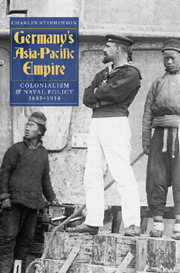Book contents
- Frontmatter
- Contents
- List of Illustrations
- List of Maps and Tables
- Introduction
- 1 Bismarck and Empire: 1885–1888. Kaiser Wilhelm's Land, the Bismarck Archipelago, the Marshall Islands and Nauru
- 2 The Acquisition of Kiautschou: 1897
- 3 China 1897–1914: Colonial Development and Political Turbulence
- 4 Tectonic Shift 1: 1898–1899. Spain and the USA, Germany, Micronesia and Samoa
- 5 Tectonic Shift 2: 1902–1914. Japan and Russia, Britain and Dominion Defence, the United States
- 6 War. August 1914
- 7 Naval Plans and Operations 1897–1914
- 8 Kiautschou: Naval and Military Operations 22 August–28 September 1914
- 9 Tsingtau: Naval and Military Operations 28 September–7 November 1914
- 10 Aftermath
- Notes to the Text
- Bibliography
- Index
9 - Tsingtau: Naval and Military Operations 28 September–7 November 1914
Published online by Cambridge University Press: 12 September 2012
- Frontmatter
- Contents
- List of Illustrations
- List of Maps and Tables
- Introduction
- 1 Bismarck and Empire: 1885–1888. Kaiser Wilhelm's Land, the Bismarck Archipelago, the Marshall Islands and Nauru
- 2 The Acquisition of Kiautschou: 1897
- 3 China 1897–1914: Colonial Development and Political Turbulence
- 4 Tectonic Shift 1: 1898–1899. Spain and the USA, Germany, Micronesia and Samoa
- 5 Tectonic Shift 2: 1902–1914. Japan and Russia, Britain and Dominion Defence, the United States
- 6 War. August 1914
- 7 Naval Plans and Operations 1897–1914
- 8 Kiautschou: Naval and Military Operations 22 August–28 September 1914
- 9 Tsingtau: Naval and Military Operations 28 September–7 November 1914
- 10 Aftermath
- Notes to the Text
- Bibliography
- Index
Summary
The Japanese Army was, in August 1914, the only modern force that had direct experience of conducting formal siege operations. This experience had been gained a decade earlier during the investment of Port Arthur, an almost isolated campaign of the Russo-Japanese War of 1904–5, by Japan's Third Army under General Nogi Maresuke. This operation had been accomplished once before by Nogi, on 21 November 1894, during the Sino-Japanese War. On that occasion, the 1st Infantry Brigade, with Nogi in command as a major-general, had successfully stormed the Chinese-held defences and taken occupation in only one day with minimal losses. His second attempt was not to be so easy, and the Third Army, initially comprising some 90,000 personnel, was engaged from 1 August 1904 to 2 January 1905, incurring massive casualties of around 55,000–60,000 in the process. Initially, Nogi had attempted to emulate his 1894 feat with attempts to penetrate the Russian-held defences by infantry assault; these were only called off on 24 August after some 16,000 men had been lost. Kamio and the Japanese Army did not intend to relearn the lesson, and, even if the defences of Tsingtau in 1914 in no way compared with those of Port Arthur in 1904, they were nevertheless treated with respect.
Not only the lessons learned during the 1904–5 siege were used at Tsingtau in 1914; so were some of the key offensive weapons. In order to reduce the Port Arthur defences the Japanese had dismantled, shipped across the Yellow Sea, re-assembled, and emplaced several of their coast defence howitzers.
- Type
- Chapter
- Information
- Germany's Asia-Pacific EmpireColonialism and Naval Policy, 1885–1914, pp. 153 - 176Publisher: Boydell & BrewerPrint publication year: 2009



